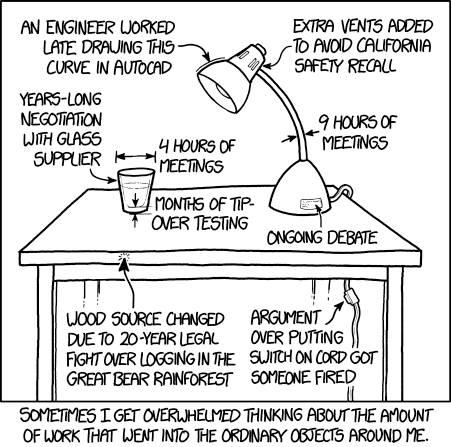In any organization, there are tasks that have to be done if anything is going to be accomplished or produced. So the organization has to decide which jobs in the organization are responsible for completing those tasks. In workplaces, this decision process is referred to as “job design” – putting different tasks together to create jobs.
Ideally, according to job characteristics theory, a job has skill variety, task significance (feeling like the task contributes something meaningful), autonomy, and the opportunity to get performance feedback. All of these make the job enjoyable for the worker who has that job. The organization also has to ensure that the tasks in one job don’t overlap with or duplicate tasks in other jobs, and that all the tasks in the organization are assigned to a job.
However, tasks in a workplace are not always easy to fully define, or to fit inside clear boundaries. Think of something like assigning an employee to organize a training session. There are multiple tasks involved in that one assignment: finding a place to hold the session, arranging for someone to facilitate the training, getting any supplies that might be needed for the training, determining which employees need the training, maybe arranging replacements for those employees while they are attending the trainees, ordering snacks or meals for the facilitator and the trainees, ensuring the trainer gets paid, and so on. “Shadow work” is the term that’s used to describe those largely unrecognized tasks associated with what seems to be a single responsibility. And in some organizations, shadow work is becoming a very contentious issue.
Employees may do shadow work just so that they can get other tasks done, and then find that they then get assigned more shadow work – often without any additional pay or adjustment to their workload. There may also be status-related assumptions around shadow work, such as a higher-level employee expecting someone in a support position or lower-ranked position to do their additional tasks. Shadow work may also be generated by the organization taking on new projects with no clear assignment of responsibility, or by the organization removing positions that used to do a single small task for many different areas in the organization.
According to some reports, many organizations are turning a blind eye to shadow work by either refusing to acknowledge that it exists, or by reassigning it to other parts of the organization – even to customers. For example, making customers enter their own identifying information when they call the organization or use its website saves the organization the cost of having its own employees collect that information, even if providing that information is difficult or time-consuming for the customer.
Last year, Cornell University in the US recently created a task force to look at the issue of shadow work in its organization. Although it’s somewhat amusing that the response to complaints about too much shadow work was to create a committee to do more work, the task force’s report was very useful in highlighting some of the larger negative impacts of shadow work – for example, when researchers spend “inordinate amounts of time” doing administrative work such as making travel arrangements. Work like this used to be handled by centralized support staff at the university, but that staffing cutbacks in those areas have been based on the unspoken expectation that the work will instead be done elsewhere. That not only meant a loss of expertise – because the centralized staff did that work regularly, they became very proficient at it – but also an unexpected displacement of work onto departments or individuals that may not have the capacity to absorb it.
It’s maybe not too surprising that organizations ignore the negative impacts of shadow work when ignoring it means saving money. That same attitude can be seen in the displacement of shadow work onto customers, or when customer interactions are designed with the goal of saving money rather than building respectful relationships. This recent and rather eye-opening article from Fortune magazine describes how some companies deliberately make their customer service so unpleasant – with, for example, deliberate understaffing or knowingly excessive wait times – that they can then generate revenue through imposing additional fees for access to better-quality service. Admittedly, this is a model that is only possible in deregulated environments where consumers have few alternative options – but in essence, as the article says, this is “a business model that rewards its own incompetence by charging users to escape the service malfeasance”.
Organizations that use this kind of business model, and who turn a blind eye to shadow work, are both focused on tangible cost savings. But both are also ignoring the larger, intangible costs of the negative impacts of these practices. In the long run, disgruntled consumers and employees who feel disrespected are not positive assets for organizations. Shadow work and deliberately unpleasant customer service practices both reflect unsettling, narrowly-focused attitudes on the parts of organizational decision-makers, and both are something that organizations need to think about very carefully.

I find some of your posts incredibly fascinating. I never game shadow work much thought – much less knew there was a term for it.
To quote: “When you’ve been in this industry as long as I have (about five minutes) you’ll realise these things work themselves out”. Ignoring the fact that it is always others who pick up the slack and resolve the ignored problems.
First it was the accountants who only understood the numbers and then it was the salesmen/women who knew how to sell themselves and pretend a competence that they did not have (politicians Trump all).
After long and careful consideration and taking all factors into account, I have come to the conclusion that the only solution involves a dart gun loaded with enough gin and tonic to fell an elephant, followed by decapitation from the neck up. Well one can dream. Have a nice day. 😀 😀